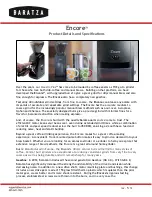
13
4. Stabilize wheel by holding opposite wheel
firmly, or placing a wood wedge between wheel
and tool rest.
Figure 9-1: wheel replacement
5. Unscrew arbor nut (D) with a wrench.
Note
: Turn the nut on the right-hand wheel
counterclockwise
to loosen. Turn the nut on the
left-hand wheel
clockwise
to loosen.
6. Remove outer flange (E), wheel (F), and inner
flange.
7. Clean flanges. Check the flanges to make sure
they are flat. Wheel flanges that are not flat will
cause the wheel to wobble.
8. Inspect the new grinding wheel and perform a
“ring test”. Do not install a damaged wheel.
9. Install inner flange, wheel (F), outer flange (E)
and nut (D) on the shaft. Tighten nut.
Do not overtighten nut;
this may cause the wheel to crack. Maximum
safe torque on nut is 20 lbf•ft (270 kgf•cm).
10. Reinstall guard cover. Adjust spark guards and
tool rests to 1/16" clearance from wheel.
9.4
Wheel balancing
With the grinder
unplugged from the power
source
, and arbor nuts snugged down, rotate
wheels by hand and observe their motion.
A grinding wheel has proper balance when:
1.
The wheel’s outside face spins true and round;
that is, its circumference rotates concentric to
the arbor.
2. There is no side-to-side wobble.
The operator who takes time to patiently perform
needed adjustments will be rewarded by wheels
running true, and accurate grinding of work pieces.
9.4.1
Adjusting concentricity
If the outside face is not rotating concentric to arbor,
try shifting the wheel closer to arbor centerline
before tightening the nut.
Another method of achieving concentricity is the use
of a wheel dresser. “Dressing” is the removal of the
current layer of abrasive to expose a fresh surface.
A wheel dresser is also used to “true” a wheel; that
is, to make the grinding surface parallel to the tool
rest, so the entire wheel face presents an even
surface to the work piece. Proper use of a wheel
dresser will eliminate high spots and result in
concentric rotation about the arbor, as well as
minimize vibration. See
sect. 9.5
.
9.4.2
Correcting side-to-side wobble
The IBG-8VS Grinder has large, machined flanges,
making wobble unlikely if a good quality grinding
wheel is used. Should a wheel exhibit need for
adjustment:
1. Loosen nut and rotate the outer flange a little.
Snug the nut and spin the wheel by hand to
check.
2. If wobble still exists, continue repeating step 1,
rotating outer flange incrementally in the same
direction. See Figure 9-2. Make sure to keep
the wheel in the same position each time.
Figure 9-2: wheel balancing
3. If complete rotation of outer flange has proved
ineffective, remove nut, outer flange, and wheel
(keep wheel in same orientation by placing a
pencil mark on it somewhere for reference).
Then rotate inner flange about 90° and repeat
the above steps for the outer flange.
4. Continue this combination of flange movements
until the wobble is eliminated.
If required, a shim made of paper or card stock may
be placed between flange and wheel side.
NOTE: Very slight wobble may still exist at spin-up
and spin-down, but will not affect normal speed
operation.









































